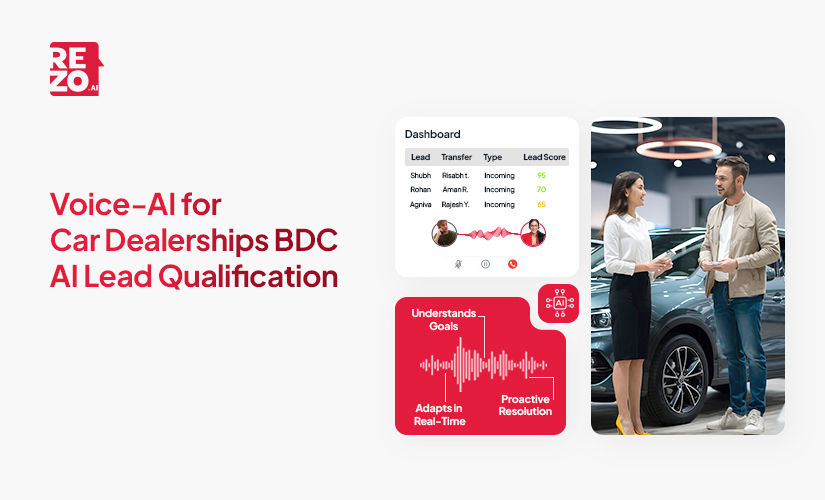
Voice-AI for Car Dealerships BDC: AI Lead Qualification in 2025
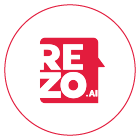
Voice-AI for Car Dealerships BDC: AI Lead Qualification in 2025

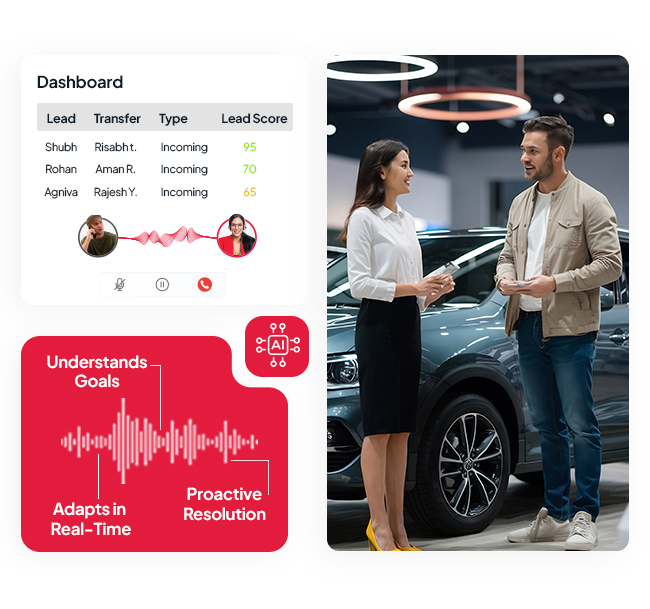
With Voice AI, automotive Business Development Centers (BDCs) are entering a new era of customer engagement, responding instantly, and offering uninterrupted support, all of which surpass the capabilities of traditional teams to match.
As customer expectations for a quick, personalized service has risen, shifting to Voice AI has become a necessity for dealerships aiming to capture every lead and deliver seamless experiences to the customers.
In this blog, you’ll discover:
- How Voice AI is transforming BDC workflows
- Why adopting Voice AI is crucial for BDCs today
- Real-world examples of dealerships successfully using Voice AI
- Key benefits dealerships gain from this digital transformation
What is a Business Development Center (BDC)?
%20works.jpg)
A Business Development Center (BDC) is a dedicated department commonly found in automotive dealerships that manages all customer engagement, both inbound and outbound, across phone, email, and online channels.
Its core functions include generating and qualifying leads, setting appointments for sales and service, and ensuring a seamless customer experience. By acting as the central communication hub, a BDC helps dealerships boost efficiency, improve lead conversion rates, and enhance customer satisfaction.
Key Functions of a Business Development Center (BDC):
- Conducts outbound calls to follow up with prospects and previous customers.
- Maintains and updates customer data in the dealership’s CRM system.
- Manages inbound leads from calls, emails, and online inquiries.
A BDC is the backbone of modern dealership operations, driving growth by optimizing every customer interaction.
Why Traditional BDCs Are Struggling?
Traditional Business Development Centers are facing an unprecedented crisis as they grapple with fundamental challenges that threaten their effectiveness and profitability. What once served as a promising solution for customer engagement and lead management is now becoming a pain point for many dealerships and auto dealers.
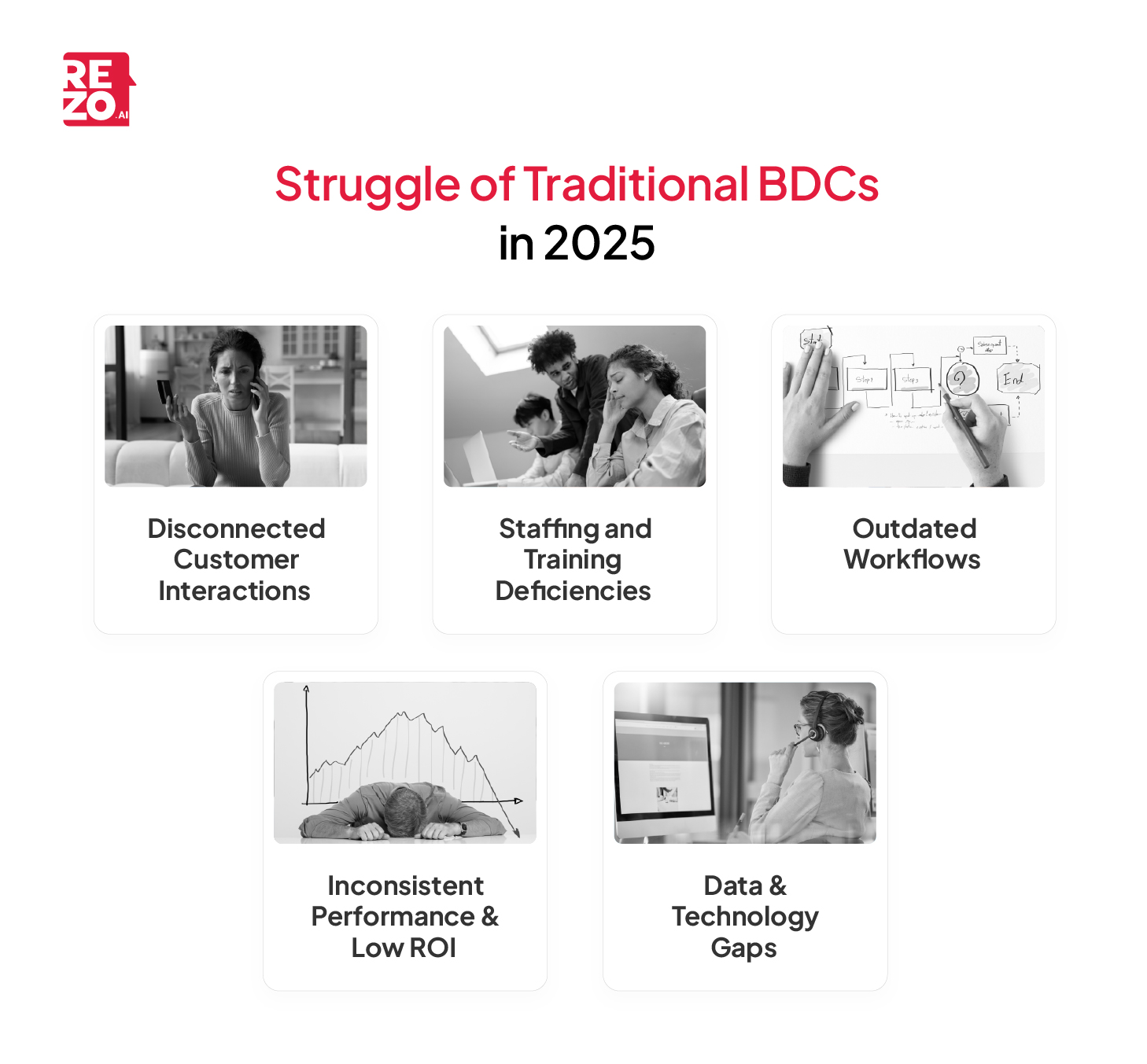
1. Disconnected Customer Interactions
- Omnichannel Gaps: Costumers now expect seamless engagement across channels (phone, email, SMS, social, web). Many traditional business development efforts lack omnichannel capabilities, leading to fragmented customer experiences.
- Personalization Deficit: Without integrated data and advanced customer relationship management tools, BDCs struggle to deliver personalized interactions, resulting in lower customer satisfaction and missed opportunities for relationship-building.
2. Staffing and Training Deficiencies
- High Turnover Rates: The average dealership employee turnover rate is 46%, with sales positions often staffed by BDCs experiencing up to 80% annual turnover. This instability leads to inconsistent customer experiences and increased training costs.
- Cost of Turnover: Each salesperson leaving can cost a dealership up to $45,000, with total annual turnover costs averaging nearly $439,000 per dealership. (Dealertrack)
3. Outdated Processes
- Script Reliance: Many BDCs still use rigid scripts and manual processes, which are not suited for handling complex customer inquiries.
- Training Gaps: Inadequate or outdated training programs result in underprepared staff, further reducing the quality of customer interactions and lead management.
4. Inconsistent Performance and ROI Concerns
- Lead Follow-Up Issues: Studies show that contacting a lead within five minutes increases the chance of conversion by 21 times, yet many BDCs fail to respond promptly, leading to lost sales.
- Conversion Rates: Typical lead-to-sale conversion rates for BDCs hover around 10-15%, with many leads wasted due to insufficient follow-up or poor process adherence.
5. Data & Technology Gaps
- Fragmented Data: Siloed and outdated systems prevent BDCs from accessing a unified customer view, making it difficult to deliver consistent, data-driven service.
- Technology Adoption: While 90% of small and medium businesses invest in digital technology, only 5% use these tools efficiently, indicating a significant gap in effective technology integration within BDCs.
How Agentic AI-Powered Voice is Solving the BDC Crisis
To overcome these limitations, the best alternative for traditional BDC challenges is to integrate agentic AI-powered Voice into auto dealership operations.
By leveraging agentic ai, dealerships can automate routine tasks, streamline business operations, and deliver more personalized customer experiences that align with modern market trends.
Here’s how Agentic AI-powered Voice works within a BDC:
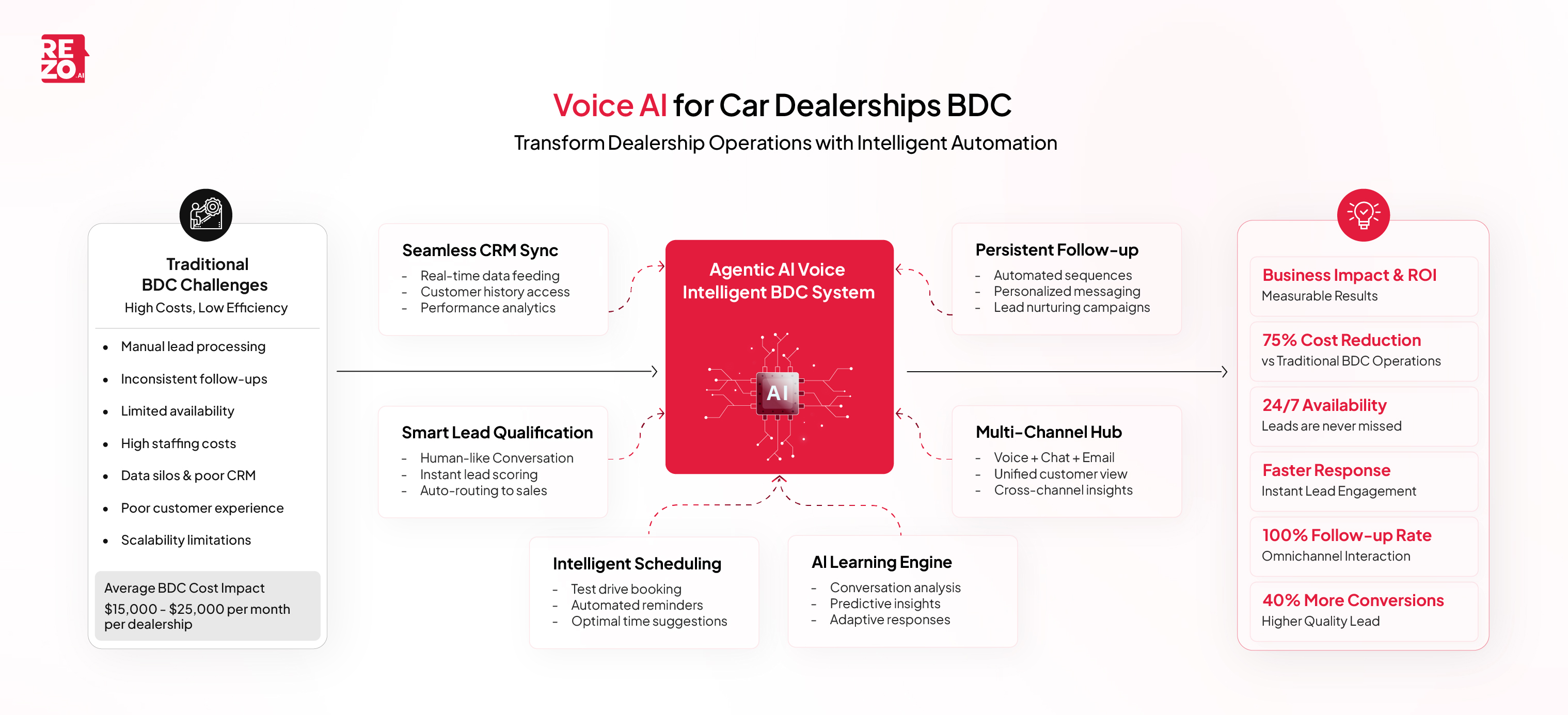
- Automated Lead Handling: AI-powered automation enables Voice AI to answer inbound calls and initiate outbound communications, qualifying leads through natural, human-like conversations. This process collects valuable customer data and lead data, which is then routed to the appropriate sales or service teams, enhancing business development efforts and lead generation.
- Appointment Scheduling: AI systems can access dealership calendars, book appointments for test drives or service visits, and send automated confirmations or reminders. This reduces manual data entry and ensures operational efficiency.
- Consistent Follow-Up: AI agents ensure every prospect and customer receives timely, consistent follow-up calls, improving customer satisfaction and engagement while supporting business growth.
- CRM Integration: Every customer interaction is automatically logged, with customer data and call outcomes synced to the dealership’s customer relationship management (CRM) system. This integration enriches company data, supports data analysis, and provides actionable insights for sales and marketing teams.
- Contextual, Adaptive Conversations: Leveraging advanced natural language processing and machine learning, Voice AI understands customer behavior and intent, adapts responses in real time, and can handle complex queries or escalate to a human agent when necessary. This results in more personalized customer experiences and improved customer interactions.
- Multi-Channel Engagement: Voice AI coordinates with other AI agents managing chat, email, or SMS, ensuring a seamless and unified customer experience across all touchpoints. This supports business development processes and enhances customer engagement.
- Continuous Learning: The system analyzes past data, including previous conversations and outcomes, to refine its approach. This ongoing learning improves the ability to handle diverse scenarios and customer needs, supporting business development teams in delivering better results.
Voice AI vs Traditional BDC: A Comparative Analysis
To better understand the advantages and limitations of each approach, here’s a direct comparison of traditional BDCs and Voice AI-powered solutions across essential business metrics.
A hybrid approach using Agentic AI powered Voice for initial contact and daily tasks, with human agents handling complex cases often delivers the best results for modern BDC operations.
Understanding AI Lead Qualification in Automotive BDCs
Finding the right buyers is more important than finding a lot of buyers. AI lead qualification does exactly that for you by transforming lead qualification process, making it smarter and more efficient for dealerships.
What is AI Lead Qualification?
AI lead qualification is the use of artificial intelligence to automatically identify which customer inquiries or leads are more likely to turn into actual car buyers.
In a dealership’s Business Development Center, agents typically have to manually filter through dozens of leads to figure out who’s serious and who isn’t. Agentic AI makes that process faster, smarter, and more accurate.
Instead of relying on gut feeling or simple checklists, AI analyzes several types of data like:
- What vehicles they looked at online?
- How they engage with marketing emails?
- Their past visits to the dealership and more.
It uses that information to score or rank leads so BDC agents know where to focus their time.
Traditional Lead Qualification vs Agentic AI Lead Qualification
Let’s break it down:
Let’s take an Example:
Imagine your dealership gets 100 website inquiries in a day.
In a traditional setup:
- They call or email based on a general script.
- Your agents manually look at each lead.
- They might miss leads who were ready to buy or waste time on those just browsing.
With Agentic AI:
- As soon as someone fills out a form or visits certain pages on your site, AI evaluates their behavior.
- It can automatically ask follow-up questions: Are you planning to buy in the next 30 days?
- High-potential leads are flagged and sent straight to BDC agents for personal follow-up.
- The rest are nurtured with personalized messages or emails until they’re ready to buy.
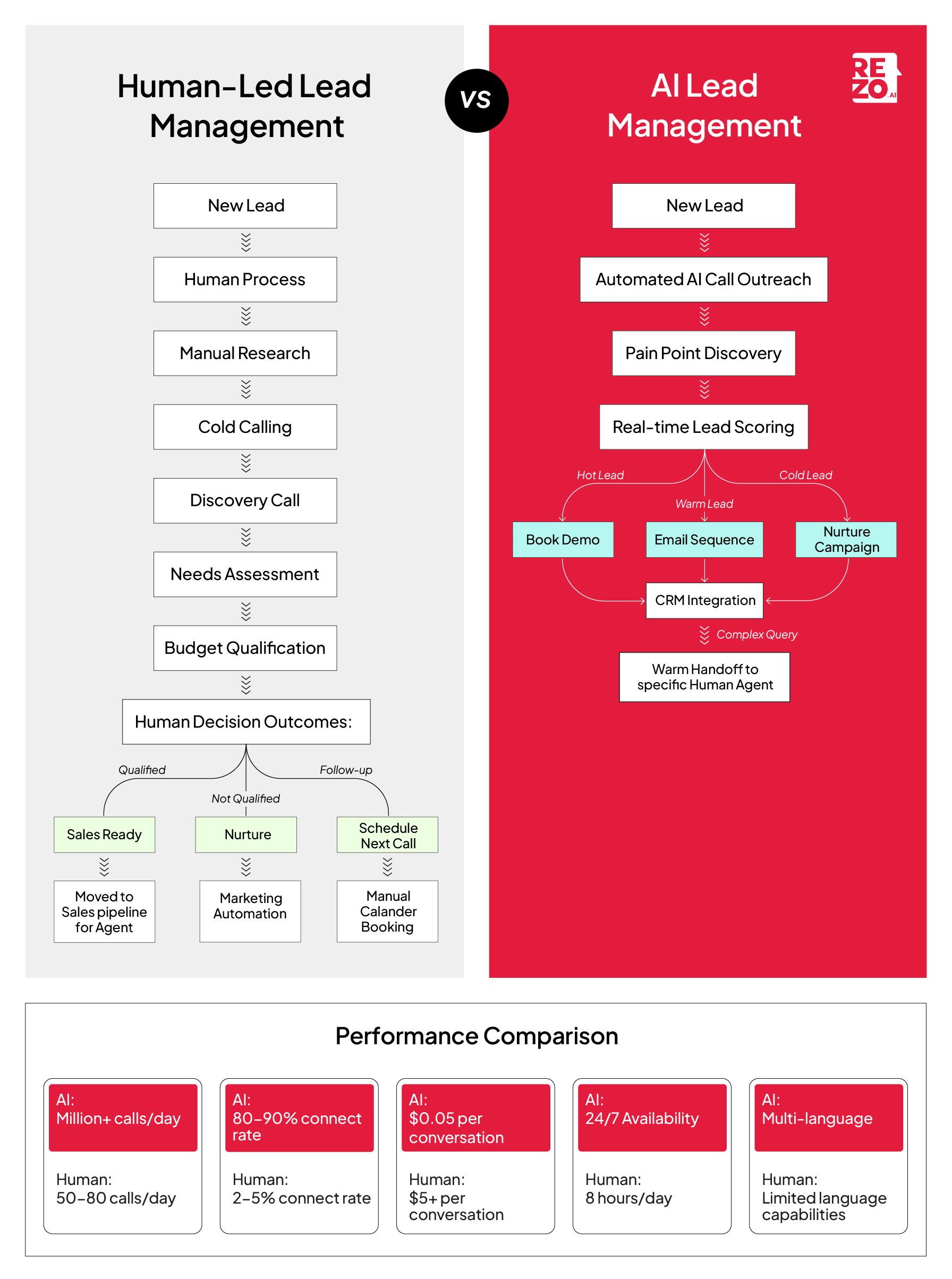
AI Lead Qualification: Step-by-Step Process
The journey from initial customer inquiry to qualified lead is where AI BDC operations truly transform automotive business development. By leveraging artificial intelligence and ai powered automation, dealerships can streamline their sales process while enhancing customer experience at every touchpoint.
Step 1: Initial Lead Capture & Data Collection
The qualification process begins when potential customers interact with your dealership through various channels. AI systems automatically capture and analyze customer data from multiple touchpoints, enabling business development teams to understand lead behavior patterns instantly.
AI tools collect information from:
- Website Activity: Page views, time spent, vehicle searches, and form submissions
- Digital Interactions: Email opens, chat conversations, and social media engagement
- Customer relationship management systems: Previous visits, service history, and past inquiries
- Communication Channels: Phone calls, text messages, and live chat sessions
This data analysis happens in real-time through machine learning algorithms, ensuring business development efforts capture every potential opportunity.
AI agents then instantly builds comprehensive profiles by gathering demographic information, behavioral patterns, and engagement metrics, transforming raw data into actionable insights.
Step 2: Automated Lead Scoring & Prioritization
Once data is collected, AI-powered lead scoring algorithms immediately assign each lead a score based on their likelihood to convert. This predictive analytics approach helps sales and marketing teams to focus their efforts on the most promising prospects.
Real-Time Scoring Process
- Predictive Analytics: AI analyzes browsing history, CRM activity, and social signals to forecast purchase likelihood.
- Behavior Analysis: The system evaluates actions like requesting quotes, scheduling test drives, or clicking on specific vehicle listings.
- Intent Recognition: Advanced natural language processing interprets tone and urgency in messages, automatically boosting scores for high-intent phrases.
Scoring Scale & Actions
- 90-100 Points: Hot leads ready for immediate human contact.
- 70-89 Points: Warm leads requiring personalized follow-up by AI.
- 50-69 Points: Moderate leads for AI nurturing.
- Below 50 Points: Cold leads for long-term marketing efforts.
This approach eliminates guesswork from business development processes, enabling sales teams to make informed decisions about where to invest their time and energy.
Step 3: Intelligent Lead Routing & Assignment
AI for business development doesn't just score leads, it ensures they reach the right person at the right time through autonomous routing algorithms that optimize operational efficiency.
- Automated Routing: High-scoring leads (90+) are instantly routed to available business development teams.
- Smart Assignment: AI matches leads to agents based on specialization, availability, and sales performance.
- Escalation Rules: Time-sensitive leads bypass queues and trigger immediate alerts.
- Load Balancing: AI distributes leads evenly across team members to prevent overload.
This ai strategy ensures customer satisfaction while maximizing revenue growth potential through optimal resource allocation.
Step 4: Automated Initial Engagement
While human agents prepare for high-priority leads, AI powered systems handle immediate response, creating personalized customer experiences from the first interaction.
Instant Response Capabilities
- AI Chatbots: Engage website visitors immediately with qualifying questions.
- Marketing automation: Send personalized follow-up messages based on lead behavior.
- Voice AI: Handle incoming calls 24/7, gathering initial qualification information.
- Omnichannel Messaging: Initiate conversations through customer's preferred communication channel.
Key Qualifying Questions Asked by AI
- Purchase timeline and urgency
- Budget range and financing needs
- Vehicle preferences and requirements
- Contact information and availability
- Trade-in vehicle details
These customer interactions are enhanced by data enrichment processes that provide context about market trends and customer preferences.
Step 5: Continuous Lead Nurturing & Re-engagement
Implementing Agentic AI for ongoing customer engagement ensures no opportunity is lost through nurturing campaigns that adapt to changing customer behavior.
- Automated Follow-ups: Personalized messages sent at optimal times based on lead behavior.
- Content Personalization: Tailored vehicle recommendations and promotions.
- Re-engagement Campaigns: AI identifies dormant leads and triggers targeted outreach.
- Behavioral Triggers: Automatic responses to specific actions like returning to the website.
This approach addresses common pain points in traditional business development strategies while delivering more personalized experiences.
Step 6: Human Handoff & Qualification Completion
When leads reach the appropriate score threshold, Agentic AI seamlessly transfer them to human agents, ensuring continuity in the customer experience.
Handoff Process:
- Complete Lead Profile: AI provides agents with full customer history and preferences.
- Recommended Actions: Suggests next best action based on lead scoring and behavior patterns.
- Conversation Context: Shares previous AI interactions to ensure continuity.
- Appointment Scheduling: AI can book test drives or meetings before human contact.
Final Qualification Steps
Sales teams use AI insights to complete qualification, leveraging valuable insights from past data and predictive analytics to assess purchase readiness and customer acquisition potential.
Key Automation Touchpoints Throughout the Process:
Continuous Learning & Optimization
AI models improve qualification accuracy over time through its sophisticate learning mechanisms that drive business growth:
- Machine Learning: Algorithms learn from successful conversions to refine scoring models
- Pattern Recognition: Identifying new behaviors that indicate purchase intent
- Seasonal Adjustments: Adapting to market trends and seasonal buying patterns
- Performance Analytics: Tracking conversion rates and adjusting thresholds accordingly
Key Benefits of AI-Powered BDCs
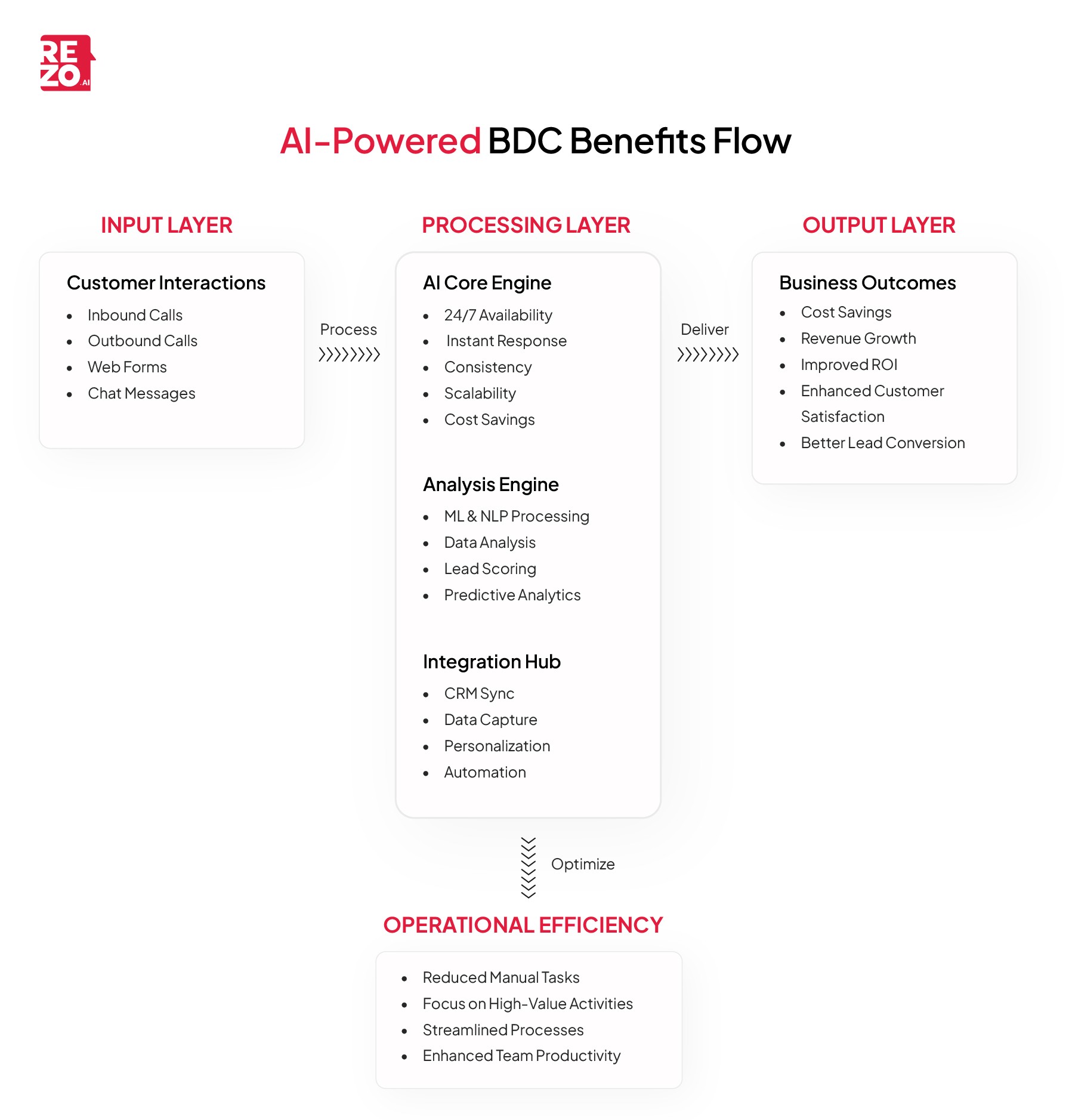
- 24/7 Availability: AI agents ensure customer engagement around the clock, capturing every lead and supporting customer acquisition efforts even outside traditional business hours.
- Instant Response & Consistency: AI-powered automation delivers immediate, uniform responses to customer interactions, enhancing customer satisfaction and building trust.
- Scalability & Cost Savings: AI systems handle high volumes of inbound and outbound communications without increasing headcount, resulting in significant cost savings and improved ROI.
- Enhanced Data Analysis: Machine learning and natural language processing enable BDCs to analyze sales calls, customer behavior, and lead data, enriching company data and supporting informed decisions.
- Seamless CRM Integration: AI tools integrate with customer relationship management platforms, ensuring valuable insights from every customer interaction are captured and utilized for business development efforts.
- Improved Lead Generation & Scoring: AI-powered lead scoring and predictive analytics help sales and marketing teams prioritize high-potential leads, boosting sales performance and revenue growth.
- Personalized Customer Experiences: AI enables businesses to deliver more personalized customer engagement by analyzing past data and tailoring communications to individual preferences.
- Operational Efficiency: Automating repetitive tasks and data entry allows business development teams to focus on high-value activities, driving business development processes forward.
The Competitive Edge of AI Adoption
Adopting AI in BDCs gives dealerships a competitive edge by enabling them to leverage AI capabilities for better customer engagement, higher customer satisfaction, and more effective business development initiatives. AI implementation not only supports business leaders in making data-driven decisions but also helps marketing teams automate campaigns, analyze market trends, and optimize business development efforts for sustained growth.
In summary, AI-powered BDCs are setting a new standard for business development by automating routine tasks, enriching customer data, and empowering teams to deliver exceptional customer experiences ultimately driving revenue growth and long-term success.
Frequently Asked Questions (FAQs)

Take the leap towards innovation with Rezo.ai
Get started now













